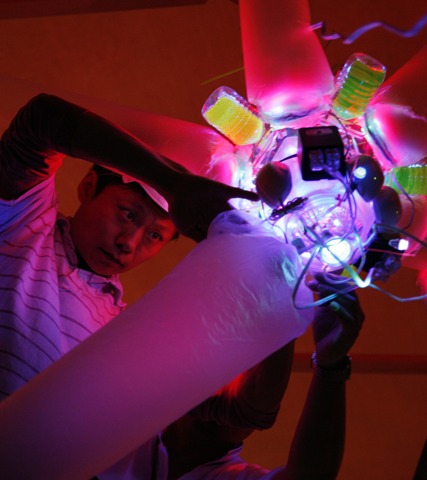Shih Chieh Huang’s “The Bright Beneath” at the Natural History Museum
Inspired by bioluminescent undersea creatures, an installation artist creates an unearthly world
/https://tf-cmsv2-smithsonianmag-media.s3.amazonaws.com/filer/20110912020006the-bright-beneath-small.jpg)
If you venture to the back of the Natural History Museum‘s Sant Ocean Hall, behind the enormous whale models and preserved jellyfish specimens, you’ll find what is perhaps the museum’s strangest organism: a computerized, plastic-tentacled creature, complete with pulsing florescent lights, robotic beeping, and a pair of blinking eyes staring out from a small LCD screen. It twists and turns overhead above a small colony of color-radiating plastic bags clustered on the floor, puffing up and contracting together in slow-motion.
Spread across the gallery are close evolutionary relatives of these creatures, each wriggling independently in their habitat, as though dancing to a silent symphony. Taken together, the creatures in the gallery evoke an exotic undersea ecosystem and are so hypnotic that unprepared visitors walking by might catch themselves staying for far longer than they imagined.
“What I’m trying to do is create that moment when you’re looking at something, not really thinking about anything else, just admiring its beauty in its own way,” said Shih Chieh Huang, the New York-based installation artist who gave me a tour of his latest creation, “The Bright Beneath,” last week.
Huang first came to the Smithsonian in 2007 as part of the museum’s Artist Research Fellow program and soon immersed himself in the collection of bioluminescent organisms.
“I’ve always been interested in science since I was little,” he said. “During the time I was doing the research, I really had this inspirational boost, in terms of the forms, the movement, the colors and the different light patterns.” Working with Lynne Parenti, a curator in the museum’s division of fishes, he was astounded by the adaptations of deep undersea organisms, and the incredible variety and subtlety represented across species. “Before, I was doing more repetitive movements, but as I was looking at these creatures, I saw that, for example, the tentacle is not always uniform. They are making different shapes—sometimes they’re symmetrical, sometimes they’re not.”
Huang proceeded to further evolve the types of installations he had done for other shows, using his unique construction techniques to make ordinary objects come alive. “A lot of these materials, I have them at home. They’re very familiar, and I feel close to them, because they’re not too foreign,” he said. “They are made to do one thing. But I always think, ‘what else can they do?’” He showed me how the “tentacles” are pieces of plastic garbage bags, cut and taped in different shapes, and their movement is powered by the alternating inhaling and exhaling of computer fans, programmed by a central circuit board. The vibrant colors are produced by a mix of highlighter ink and Mr. Clean.
Within the exhibition, the creatures seem to have an evolutionary relationship. While most are blind, a few have small screens with videos of human eyes displayed, which in turn control the movement of tentacles via light sensors attached to the screens. “When I was doing research, I read about the Cambrian explosion and the development of the eye. In this installation, you have things that don’t have eyes, and they’re like these primitive beings, and then eyes are growing and they’re able to control things with them, but still in a very primitive kind of way,” Huang said.
For an artist like Huang, designing an installation for the Natural History Museum is a very different type of challenge than what he’s used to. “In an art museum, people are looking at things through the historical context of art and different art movements,” he said. “It’s very refreshing, in a way, that people aren’t thinking about that here, they’re just seeing them as they are.”
Huang sees his work as an important marriage between art and science. “Normally, scientists never work with artists, and artists never work with scientists,” he said. But he feels that art can provide a unique window for the public to understand some of science’s most remarkable discoveries. “I’m not trying to recreate or model the organisms in any way,” he told me as we stared at his creation. “I’m just trying to capture that feeling of ‘wow!’”
“The Bright Beneath: The Luminous Art of Shih Chieh Huang,” is on exhibit at the Natural History Museum through January 8, 2012.
/https://tf-cmsv2-smithsonianmag-media.s3.amazonaws.com/accounts/headshot/joseph-stromberg-240.jpg)

/https://tf-cmsv2-smithsonianmag-media.s3.amazonaws.com/accounts/headshot/joseph-stromberg-240.jpg)